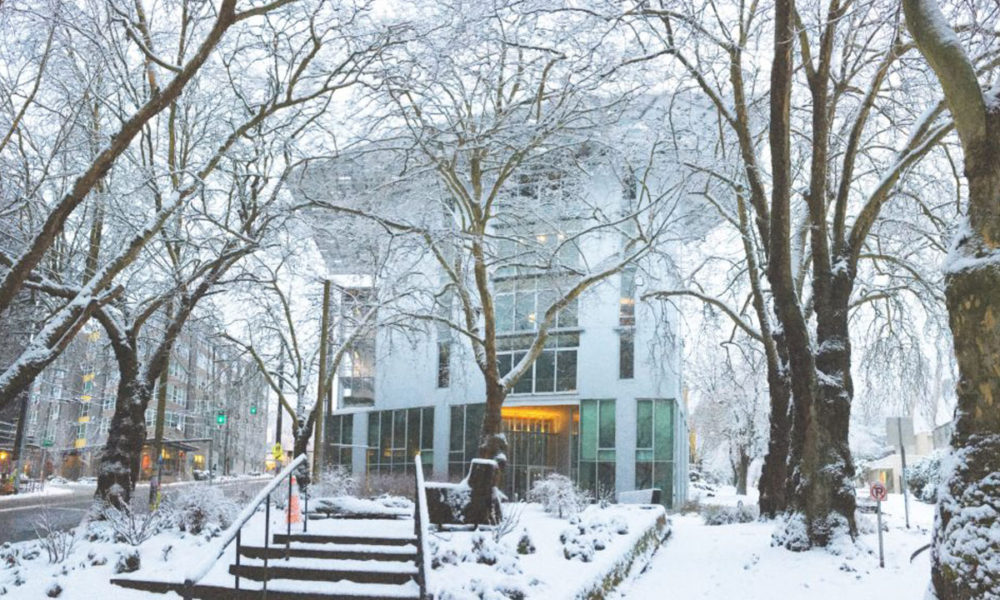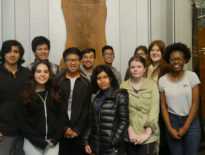When you walk through a forest, whether it’s a deciduous forest shedding its leaves on a colorful fall day, or in a eucalyptus forest in the midst of summer, where the smell of peeling bark is clearing your sinuses, it is not just your visual senses that are alive. Smell, sound, and the texture of what is underfoot are part of the experience. Occasionally we have this same multisensory experience within the built environment. The sense of discovery, awe, mystery, and exploration are apparent, and a space draws us in and resonates deeply without us being quite sure why. This is biophilic design in play.

For over a decade now, the International Living Future Institute has been reimagining what it means to live holistically on the earth and charting into unknown waters with determination, courage, and a bold vision. As we seek to create a world where Living Buildings, Communities, and Products are frequent, we recognize that a major shift in the way we approach design problems is essential. While designing as if nature and people are connected provides a design framework that can make the pathway to a Living Future possible, it is remarkable how much resistance there is to change.
Resistance to change is our biggest challenge to creating a Living Future, particularly amidst a culture where more and bigger is better. Our approach to challenge the norm takes courage, the courage to face up to what is right, to seek a goal that others may tell us is not possible, and to create innovative solutions that simply make the world a better place. Our role is to question the prevailing mindset, agitate the industry, and create greater innovation than thought possible as a result. Today, in a political climate that threatens the basics of environmental protection, social equity, and cultural richness, our work has become even more crucial. Our theory of change insists on bold moves that may seem small in number but have monumental impact.
If one Living Building creates a tipping point for the entire building-product manufacturing industry to assess their ingredients in order to avoid Red List chemicals, we have been more successful than if we engaged with 100 buildings that did not. With 53 certified buildings, the numbers of Living Buildings may seem small, but the impact is enormous. Each project is acting as a catalyst for their region, for the firms that designed the building, and for the trades that put it together. The Living Building Challenge has caused people to think about not just making our buildings better, but about our entire relationship with the planet—to reassess everything we do in the process of creating a building, and how as a result we can create excellence.

Between 2015 and 2016, the Bullitt Center had 8,422 tour participants. These visitors came from all over the world—from downtown Seattle to North Carolina, Belgium to Bhutan. They came from all fields—government, corporate, academic—and all walks of life. There were officials from the Environmental Protection Agency, the Energy Secretary, representatives from local governments, delegates from the US-China Climate Coalition; we inspired artists, young children, corporate executives, college students, utility workers, church groups, human rights lawyers, and economists. We began building partnerships. The Bullitt Center grew branches, and those branches grew tendrils, and those tendrils spread.
When the Bullitt Center was first envisioned, almost every building product contained compounds from the Red List—our compendium of toxic chemicals forbidden for Living Buildings. But we weren’t in a position to compromise, as the health of building occupants is one of the core pillars of a Living Future. Instead of pressing for a ban on these compounds, we wanted to work with companies, encourage them to innovate, and offer a helping hand. Prosoco, a Kansas-based company that provides building industry products, was inspired by our vision. They took FastFlash, their waterproofing membrane material, and redesigned it to adhere to our strict standards, completely removing phthalates, a class of toxins linked to cancer and reproductive harm. Not only did Prosoco make a phthalate-free sealant, they reformed their entire product line to offer toxin-free construction materials. Prosoco took the dive with us in order to create a better future. In such a way, the Living Building Challenge impacts not only architecture firms but the entire network of companies on which our built environment depends.

Inspired by the Bullitt Center, the Kendeda Fund has funded the Georgia Institute of Technology to build a Living Building that can catalyze the Southeast region of the US. It will be the greenest research and education facility in the Southeast, spurring technological innovation while surrounding students and professors with a space that nourishes and inspires them. In partnership with the Kendeda Fund, Georgia Tech is shaping itself as a leader in the world of design and ensuring that Atlanta becomes a hub for transformational change in the 21st century. The measure of success for this project stands not in the building alone, but in the transformation of a region to reconsider the design process and our expectations for what a building should be.
Ultimately, the Living Building Challenge aims to make waves throughout the building industry, imbuing some aspect of regenerative design into every structure, creating a movement for buildings that citizens crave and businesses demand. Owners and companies don’t have to reach for certification to be impacted by the sea change we have begun: Because of Prosoco, for example, any construction team can now use building-envelope products that are free of Red List compounds. We provide the (renewable) fuel, others add the fire, and soon it will be second nature for architects and engineers to think in terms of biophilia, ecology, and place-based design.

Each of the 370 projects registered to attempt the Living Building Challenge is a catalyst, challenging manufacturers and consumers alike to rethink the impact that products have on society and the planet. Each project deepens the human connection to the natural world. Because we have proven that Living Buildings are not just a concept but a tangible reality, we are able to dream of a future that connects people to their communities and restores balance within every ecosystem. Every day, we at ILFI blaze a trail of hope, courage, and resilience in the world of design. Our guideposts are all around us. Because we see genius in bees’ act of pollination and beauty in ferns unfurling, we know that we, too, can create things of genius and beauty. The natural world offers all the inspiration we need—all it takes is slowing down to look.




